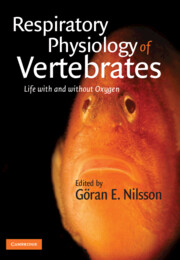Book contents
- Frontmatter
- Contents
- List of contributors
- Preface
- Abbreviations
- Part I General principles
- Part II Special cases
- 5 Adaptations to hypoxia in fishes
- 6 Breathing air in water and in air: the air-breathing fishes
- 7 Air breathers under water: diving mammals and birds
- 8 Vertebrate life at high altitude
- 9 Surviving without any oxygen
- Index
- References
6 - Breathing air in water and in air: the air-breathing fishes
Published online by Cambridge University Press: 05 June 2012
- Frontmatter
- Contents
- List of contributors
- Preface
- Abbreviations
- Part I General principles
- Part II Special cases
- 5 Adaptations to hypoxia in fishes
- 6 Breathing air in water and in air: the air-breathing fishes
- 7 Air breathers under water: diving mammals and birds
- 8 Vertebrate life at high altitude
- 9 Surviving without any oxygen
- Index
- References
Summary
Introduction
Air breathing is an auxiliary respiratory mode utilized by some fishes when environmental factors such as exposure to hypoxic water or emergence impede aquatic respiration. All of the 28, 000 living fish species use gills to exchange O2 and CO2 with their aqueous environment. However, nearly 400 species, distributed among 50 families and spanning 17 orders of bony fishes (Osteichthyes), are known to be capable of breathing air. Air breathing enables these fishes to survive in and occupy habitats in which aquatic respiration cannot be used to sustain aerobic metabolism. Among all air-breathing fishes, the principal causal factor associated with this specialization is exposure, at some point during their life history, to either chronic or periodic environmental hypoxia.
A chapter on air breathing in fishes is essential for a book about vertebrate adaptation to hypoxia, because fishes are the basal vertebrates and were also the first vertebrates to breathe air (Graham, 1997). The recent literature contains substantive accounts of the adaptations for air breathing (Graham, 1997; Graham, 1999; Graham, 2006) and emersion from water (Sayer, 2005) in fishes. Using three cases studies, this chapter shows how both hypoxia and aerial O2 access have shaped the behavior, physiology, and natural history of different fish groups.
Oxygen and water
With the increasing overlap in disciplines such as comparative physiology, field ecology, and environmental biology, there is a need for precise quantitative terminology describing the properties of water affecting respiration.
- Type
- Chapter
- Information
- Respiratory Physiology of VertebratesLife With and Without Oxygen, pp. 174 - 221Publisher: Cambridge University PressPrint publication year: 2010
References
- 21
- Cited by



